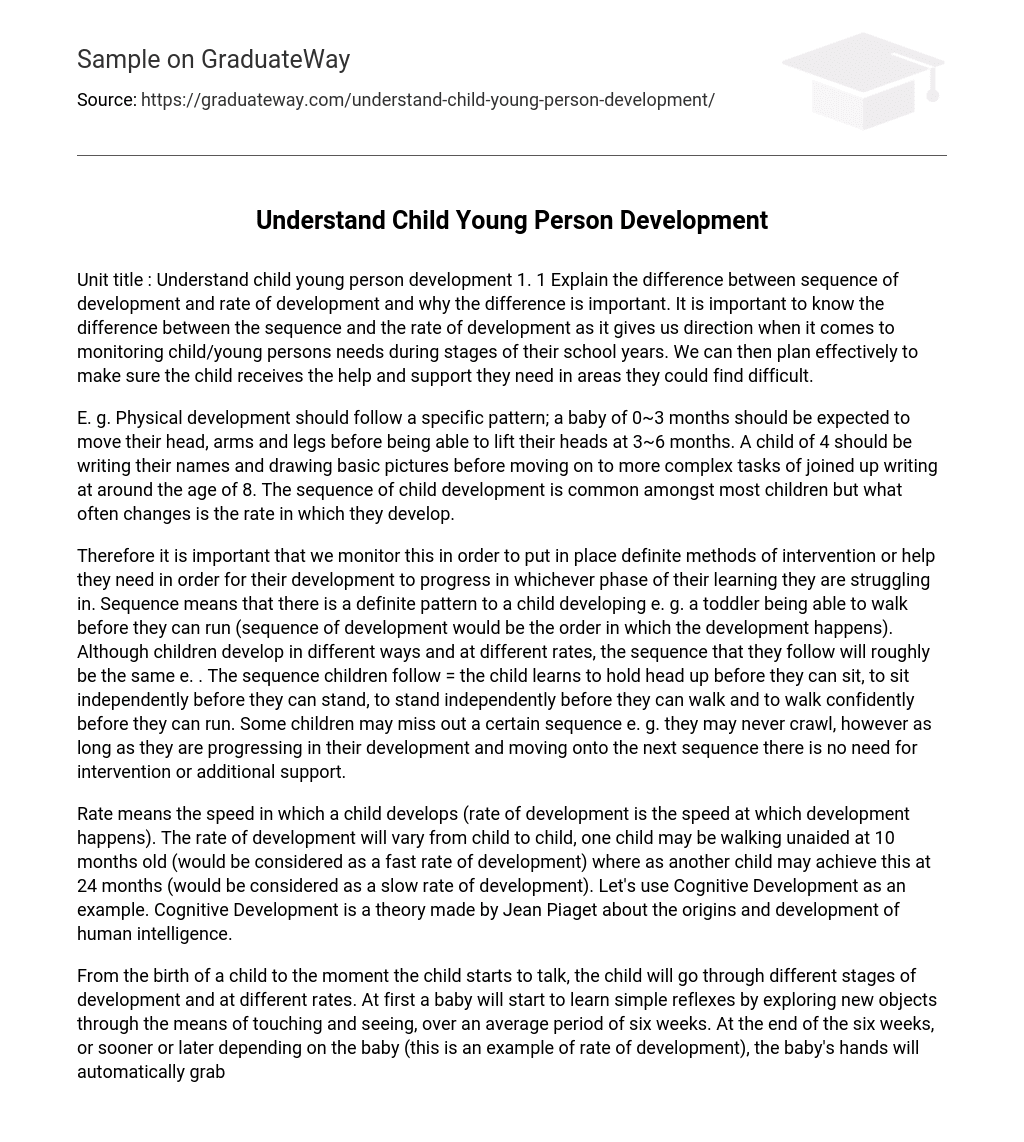It is important to know the difference between the sequence and the rate of development as it gives us direction when it comes to monitoring child/young persons needs during stages of their school years. We can then plan effectively to make sure the child receives the help and support they need in areas they could find difficult.
Physical development should follow a specific pattern; a baby of 0~3 months should be expected to move their head, arms and legs before being able to lift their heads at 3~6 months. A child of 4 should be writing their names and drawing basic pictures before moving on to more complex tasks of joined up writing at around the age of 8. The sequence of child development is common amongst most children but what often changes is the rate in which they develop.
Therefore it is important that we monitor this in order to put in place definite methods of intervention or help they need in order for their development to progress in whichever phase of their learning they are struggling in. Sequence means that there is a definite pattern to a child developing e. g. a toddler being able to walk before they can run (sequence of development would be the order in which the development happens). Although children develop in different ways and at different rates, the sequence that they follow will roughly be the same e. . The sequence children follow = the child learns to hold head up before they can sit, to sit independently before they can stand, to stand independently before they can walk and to walk confidently before they can run. Some children may miss out a certain sequence e. g. they may never crawl, however as long as they are progressing in their development and moving onto the next sequence there is no need for intervention or additional support.
Rate means the speed in which a child develops (rate of development is the speed at which development happens). The rate of development will vary from child to child, one child may be walking unaided at 10 months old (would be considered as a fast rate of development) where as another child may achieve this at 24 months (would be considered as a slow rate of development). Let’s use Cognitive Development as an example. Cognitive Development is a theory made by Jean Piaget about the origins and development of human intelligence.
From the birth of a child to the moment the child starts to talk, the child will go through different stages of development and at different rates. At first a baby will start to learn simple reflexes by exploring new objects through the means of touching and seeing, over an average period of six weeks. At the end of the six weeks, or sooner or later depending on the baby (this is an example of rate of development), the baby’s hands will automatically grab whatever it is place in its hand, due to the palmer reflex.
Once the simple reflexes have been developed the baby will go into another stage of development where it develops primary circular reactions, and after once it has accomplished it over a certain period, it will move on to yet another stage of development and so on. This is an example of sequence of development as most babies will follow a similar pattern of development, and these stages are known as sequences. Why is the difference important? When a child develops if they achieve this by sequencing it enables you to plan effectively and at the right time.
When recording the rate of development it helps us to identify any concerns that we may have within the development area, this enables you to further investigate why this is happening. Basically we can shortly define the age as sequence and the rate as what they can do. By ways of mapping out a child’s development and using milestones to give an idea of a typical child’s development for a particular age, it is easier to identify if a child is struggling in a certain area of development. This is beneficial to the child if they need additional support. . e. a child of 4 has not reached a milestone or shows signs of struggling to reach the milestone in speech, language and communication, therefore they will need additional support from care providers and will need speech therapy. Some children may be advanced in one area of development yet need support in another area.
References:
- http://www. silkysteps. com/forum/showthread. php? t=14864
- http://www. studymode. com/essays/Assignment-023Task-A2-Difference-Sequence-And-894186. html? topic
- http://www. silkysteps. com/forum/showthread. php? t=15924





